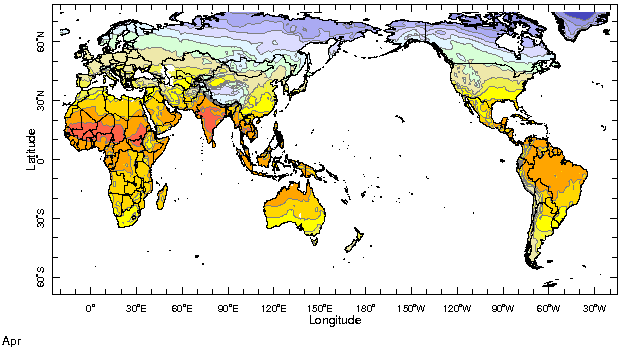|
IRI Climate Digest
May 2003
April Global Climate Summary
Climatological Background
In April, the sun's migration into the Northern Hemisphere has begun, bringing springtime to the northern mid-latitudes. The monsoon systems which still linger south of the equator will move northward following the solar heating of the continents in the next two months. In the Southern Hemisphere, fall has arrived, with cooler temperatures and a strengthening of the mid-latitude storm tracks.
Monthly Mean Temperature (1961-1990), data from the Climate Research
Unit, University of East Anglia


Monthly Mean Precipitation (1961-1990), data from the Climate Research
Unit, University of East Anglia


Temperatures
Highlights
Alaska and the eastern tip of Russia exhibited temperatures that are far above normal. While much of eastern Asia was warm in April, a large swath from eastern Europe through central Asia experienced below-normal temperatures. Much of eastern Canada, the northeastern U.S., and the west coast of the U.S. were cooler than normal, whereas above-normal temperatures were found in the continental interior. Much of western Europe was warm, as was most of the African continent.
Temperature Difference from the 1961-1990 mean, with data
from NCEP Climate Prediction Center, CAMS.


Precipitation
Highlights
A pattern of bands of above-normal precipitation north of the equator and below-normal precipitation to the south across the tropical Pacific appears to signal a northward shift of the Pacific ITCZ with respect to normal conditions.
Africa: In the Greater Horn region, heavy rains in the last half of April produced flooding in southern Ethiopia and Somalia and northern Kenya, while very dry conditions continued in eastern and southern Kenya southward into Tanzania.
South America: On top of large precipitation accumulations from previous months, unusually heavy rains fell in parts of northern and northeastern Argentina during the last half of the month, resulting in widespread flooding. Dry conditions continued in southern Colombia and Venezuela and across much of Brazil, although good rains continued in some coastal areas of northeastern Brazil.
Europe: Most of Europe experienced below-normal rainfall for a third straight month.
Asia: Areas of central Asia, including Tajikistan and Kyrgyzstan received above-normal rainfall, as did Turkey, the North China Plain, the Korean peninsula, and Japan. Dry conditions continued in southeastern China.
Australia/New Zealand: : Northern Queensland remained dry in April, and dry conditions continued in much of New Zealand.
North America: The northwestern United States received additional above-normal precipitation in April.
Precipitation Difference from 1961-1990 mean, with data
from NCEP Climate Prediction Center, CAMS-OPI.


Oceanic Conditions
Tropical Pacific: SSTs continued to decrease in April, particularly off the coast of Peru where temperatures fell 0.5 to 2.5°C from those seen in March. Temperatures also declined in the central Pacific by as much as 1.0°C, though they remain slightly above-normal in the western half of the tropical Pacific basin. See the latest IRI ENSO Update for a detailed summary and outlook.
Tropical Atlantic: Sea surface temperatures fell slightly in the Gulf of Guinea during April and averaged near-normal in much of the central and eastern tropical Atlantic. Positive anomalies remain, however, off the coast of central Africa and eastern South America.
Indian Ocean: Very few changes were seen in the Indian Ocean during April as sea surface conditions remained slightly warmer-than-normal across most of the northern and eastern portions of the basin. SSTs did increase, however, in the northern Arabian Sea and Bay of Bengal as well as in the waters south of Australia.
Mid-latitudes: Warmer-than-normal SSTs persisted in bands along 30° north and south latitudes in the Atlantic Ocean and below-normal SSTs strengthened in the Atlantic between 40° and 50° south. The northeastern Atlantic, North Sea, and Bering Sea continued to be dominated by warmer-than-normal sea surface conditions. Relatively warm SSTs also persisted in much of the southern Pacific.
Monthly Sea Surface Temperature Difference from the 1971-2000 mean,
with data from the Environmental Modeling Center, NCEP/NOAA.


Contents |
Special |
Impacts |
Climate |
Forecast
|

